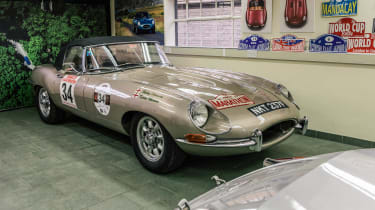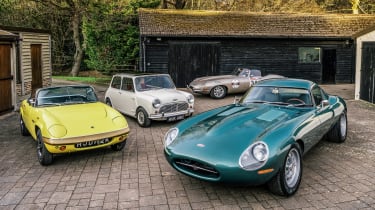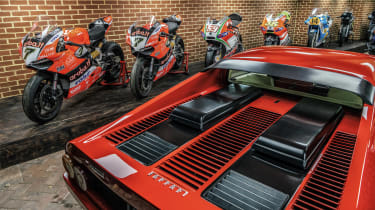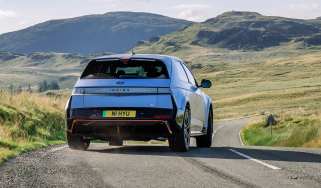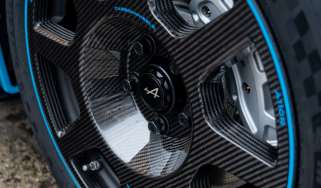My Life & Cars – Henry Pearman, Eagle E-types founder and car collector
Starting with a £25 MG Midget, bought when he was 15, Henry Pearman has traded his way up to an enviably epic car collection while also becoming a restomodding pioneer
'I saw it parked on a driveway and loved it. That was it for me. I just knew the E-type was going to be my life.’ As childhood prophecies go, few can top that of Henry Pearman, founder of Eagle E-types and custodian of a truly epic car collection.
You know you’re dealing with someone with a serious obsession when it takes them a full day to compile a list of all the cars they’ve owned. Sorry, a list of all the significant cars they’ve owned. Then again, when you learn Pearman bought his first car aged just 15 years old, and has relentlessly bought and sold cars ever since, you know that list is going to be a long one.
> My Life & Cars – Ian Callum, designer and car collector
Visiting Pearman should come with a health warning. The first time he showed me his car collection must be the best part of 20 years ago, yet there’s a corner of my mind that remains utterly blown by what I saw. Two decades later the scale and scope of Pearman’s collection – which has grown considerably and is now spread across multiple locations – still rocks me on my heels.
What you see is all the more remarkable because Pearman is entirely self-made. Born in 1963, he enjoyed a happy childhood, but as he explains, life wasn’t plain sailing: ‘As a family we were quite unlucky. My dad worked for National Benzole and then went to Shell, working at their head office in London. However, his passion was printing. In 1971 he took early retirement in his mid-forties and bought a print shop. Unfortunately, this coincided with a six-month national postal strike. The business went under and my parents basically lost everything, going from a four-bedroom house to never owning another house again. Tough times…
‘Dad picked himself up and worked his way from being an attendant on a petrol station forecourt to becoming field manager for a petrol pump company. We moved around a lot. From the age of eight I started at a new school pretty much every year, but I think that was good because it got me used to dealing with different people. My parents were just starting to get back on their feet and look for a new house when the Suez Crisis came. My dad lost his job and they were back to square one.’ Tough times indeed.
‘Family cars tended to be old, so we had to fix them. I found I had a bit of mechanical aptitude, and a bloke called Duncan Welch from the local car club I’d joined [aged 12!] took me under his wing and helped me learn. I remember him saying he’d give me a diff to replace the broken one in my mum’s Austin A40, but on condition I fitted it myself. So I went to the local motor factor, bought myself a socket set and did just that!’
Pearman’s entrepreneurial spirit took hold early, his love of cars and ability to mend them feeding his drive to earn and save money, which he would use to buy more old cars he could do up, enjoy and trade at a profit. TV’s Wheeler Dealers had nothing on him.
‘By the time I was 15 I’d saved up enough pocket money to buy my first car, a little MG Midget. It was advertised for spares or repair in the local paper and I paid for it with £25-worth of coins. Instead of doing O-level revision, I was reading David Vizard’s books on how to rebuild A-series engines. When I wasn’t working on cars I’d watch Noel Edmonds’ Multi-Coloured Swap Shop on a Saturday. That’s where I got my love of complex deals and swapping things all the time. That’s become the story of my life, really.’
Having left the local comprehensive school he embarked upon a three-year Diploma of Automobile Engineering at West Kent College in Tonbridge. ‘It was brilliant,’ says Pearman. ‘It took you up to the management level in the motor trade, but also covered mechanical stuff. The father of one of my course-mates was Jackie Epstein, a racing driver who ran the Brands Hatch Racing School, so I ended up doing my work experience there. I rode an hour and 20 minutes each way on my little 50cc two-stroke Garelli Tiger Cross. They were great times.’
As Pearman’s story unfolds, it’s clear his outlook on life means he’s always been ready to make the most of any opportunity that comes his way, however unlikely or unexpected it might be. How else could you explain a work experience stint (and eventual full-time employment) at a Rolls-Royce and Bentley specialist, Sargeants, in which the 17-year-old Pearman was taught restoration skills and acquired his eye for detail and quality. Likewise having the gumption, aged 21, to sell the stock of cars you’ve built up to start your own business – one that would become the world-famous Eagle E-types.
The cycle of buying, repairing and selling cars was relentless. ‘You name it, I’ve probably owned one,’ says Pearman with a smile. ‘By ’82 I’d graduated from college and was at Sargeants full-time. I’d worked my way up to owning a TR6, an MGB and a Gordon Keeble, but the following year I traded those, plus 500 quid, for a De Tomaso Pantera. I think it was up for £6995 at a dealer’s in Essex.’
The Pantera needed work and proved hard to sell, which tied up Pearman’s precious working capital. When the MGB V8 he was using as his daily driver broke its gearbox, he found himself in a bit of a tight spot. Largely because he’d already agreed to buy a Series 2 E-type Roadster…
‘That’s when I first learned to borrow money,’ explains Pearman. ‘I went to the bank manager and explained I’d agreed to buy a car and I hadn’t got the money. He approved my first overdraft and I’ve never stopped since. It was being able to keep the plates spinning and eventually sell those cars that started Eagle, so I suppose you could say that’s the root of everything you see here.’
Does he get stressed? ‘No, not really. I understand why borrowing scares a lot of people, but it’s not ridiculous if you’ve got the mindset to deal with it. It’s not been without risk – I remember getting finance to buy stock in June ’89, spending several hundred thousand pounds, and then the market switched off in September. The market always comes back, but sometimes you have to take a hit; go backwards to move forwards, if that makes sense.
‘The only time I’ve ever had sleepless nights was when we’d sold a few of the big-ticket cars and we had a lot of money sitting in the bank. I found it really unsettling! I’ve come to learn that I’m only relaxed if we’re extended. Then I’m good, because it just gives me more drive.’
That drive manifests itself in many ways. For starters Pearman is never ‘off’, working pretty much seven days a week and always hyper-alert to market trends and buying opportunities. ‘Some of the racing cars we’ve bought over the years – such as the Rothmans Porsche 956-001 or Daytona-winning Castrol XJR-9 Jag, or more recently the Mercedes CLK GTR race car – were once-in-a-lifetime opportunities that I simply had to make happen. It’s often the case with these sorts of cars. If you hesitate, they’re lost.’
In theory anyone could have done what Pearman has done. In practice few if any possess his passion, knowledge, energy and resilience. It’s his life’s work. You certainly can’t argue with the results; where most of us have a few model cars in our office or study, Pearman has a full-size F40 parked by his desk, plus an Onyx F1 car, the ’87 World Championship-winning Silk Cut Jaguar XJR-8 and a pair of ex-Stoner and ex-Rossi Ducati MotoGP bikes. It’s like all your wildest cheese-fuelled dreams made real.
Car traders aren’t noted for their sentimentality, but Pearman is an exception. Look beyond the iconic competition cars and motorcycles and you discover a collection within a collection. One that documents his four-wheeled life and loves in intimate fashion. Whether it’s a Mini Pickup, Frogeye Sprite, 3.5-litre Rover Coupe, coach-built Rolls-Royce or Ferrari Berlinetta Boxer, there’s a personal story behind the purchase.
‘I never buy with the view to selling, which sounds a mad thing for a car dealer to do, but even when we buy an E-type for the showroom, I like having it around for a while. I get attached to every single car. But deep down I also know I’m always chasing the next deal, so there will come a point where something will get sold, or more likely a bundle, in order to make the next deal happen. It’s a perpetual process, though I’ll concede some might call it a disease!’
One of the least impressive cars in the collection is a slightly scruffy gold E-type 4.2 Roadster on Minilites and covered in decals. Yet, ironically, it is the most important car of all to Pearman. Why? Because it’s the car he prepared himself and drove to an outright win in the 1989 Pirelli Classic Marathon. The look in his eyes makes it clear this car represents so much more than a victory. For Pearman it holds some of his fondest memories and stands for everything Eagle has gone on to become: ‘If the buildings were on fire, this would be the one I’d rescue first.’
If the wider collection is the more private expression of Pearman’s passion for cars, then the Eagle E-types business is clearly the highest profile. Pioneers of the now ubiquitous restomod scene, the first nut-and-bolt ‘zero hour’ Eagle E-type was built in 1994. Since then the exquisite restorations he builds with Paul Brace and Eagle’s skilled team of restorers have become highly coveted creations costing anywhere between £450,000 and £850,000, plus taxes.
‘So far we’ve built 56 of our Eagle Classic restorations, and we’re approaching 25 of the Special Editions, split across the Speedster and Low Drag, Lightweight and Spyder GTs. And obviously we continue to look after those cars when it comes to servicing and maintenance. We’re booked through until 2026 on restoration build slots, which is nice, but probably too long a wait to be honest. But we put so much into the cars I would rather we build them knowing they are as good as they can possibly be. We always have around 30 donor E-types in stock for our customers to choose from, and we build to a fixed price, which our customers like. Trouble is, Eagle restorations tend to take as long as they take. [A Low Drag comes in at around 8000 hours!] It’s being prepared to dedicate that extra time and effort that makes all the difference to the end product.
‘Although I’m central to both Eagle and the collection, they co-exist without being reliant upon one another. That said, sometimes if we want to embark on a really ambitious Eagle project then I’ll sell something to free up the money. That’s how we were able to work with a customer on the first Low Drag build, for example.’
Enthusiast. Trader. Racer. Restorer. Collector. Pearman is a man of many facets, and therefore almost impossible to pigeonhole. So how does he describe himself?
‘Hmm, that’s a good one. I suppose most people would describe me as a car dealer. But I’ve never really seen myself that way. I think I’m a passionate collector who occasionally has to sell things to pay for the next thing I can’t afford! Being serious for a moment, I think life changed for me around the time of the millennium, when a close friend and neighbour of ours died suddenly. She had literally just turned 50 and was full of so much fun. I decided then and there that life’s too short, and within six weeks I – actually the finance companies – had bought two 288 GTOs and a DB4 GT! They’ve long since gone to fund other deals, but my point is that cars are my absolute passion. Buying, owning and enjoying them is enormously satisfying, just as trading some of them to buy something else is hugely exciting. Especially when it means you can own something like a Le Mans-winning Jag or Porsche Group C car that you stood and watched racing in period. It’s all-consuming, but I can’t ever see myself changing. Besides, you’re only here once.’
This story was first featured in evo issue 296.


